“The triumph and tragedy of sports,” is a phrase often heard but nothing compares to the tragedy of a team losing a coach to a reportedly freak accident. This was the case in 1911 at the University of Texas. Coach Billy Wasmund was just in his second year as head coach at Texas when his untimely death occurred, shocking both the football team and the community as a whole. Here is a look at his story.
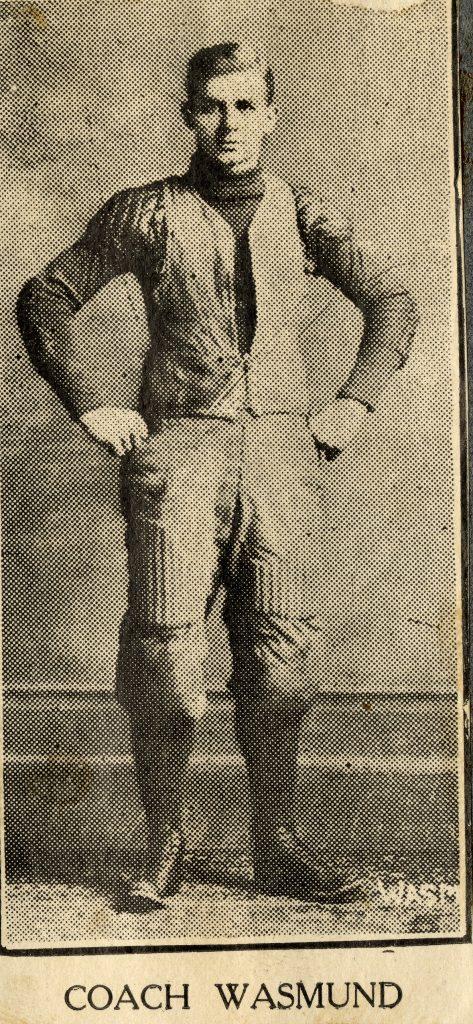
William Wasmund was born in 1887 in Michigan to a stone contractor from Germany. He had two brothers and a sister. He first began playing football in 1905 as a member of the Central High School team in Detroit, Michigan. After graduation, he attended Lafayette College in Pennsylvania where he played for a year on the football squad and attracted the attention of the Fielding “Hurry up” Yost, the Michigan coach. He transferred to Michigan after a year and joined the football squad first as a sub. Under Yost’s tutelage, he developed into a top-notch quarterback and played that position for three years from 1907-1909. He was twice picked as an All-American quarterback by the top football authorities in the country, including the American Magazine of Boston, while Walter Camp placed him on the honor roll. Wasmund graduated with a degree in Civil Engineering.
In 1910, the University of Texas sought a coach to lead their Varsity team and asked the famous Michigan coach, Yost, for recommendations. On Yost’s recommendation, Texas hired Billy Wasmund, who had no prior experience coaching, and he set about training the Varsity 11 into competitive shape.
The 1910 Longhorn football season was a successful one. After a strong start of 5-0, there were high hopes of winning the South, Southwestern, and Southern Championships, especially after beating Auburn 9-0 who was a top team at the time.
The hard fought Auburn game against a much bigger squad, as well as the following game against Baylor, who reportedly groused about calls and stalled the entire game, took a lot out of the Varsity 11. Ultimately, they didn’t win a championship, but the wheels were set in motion for the Longhorns to be a perennial contender nearly every year after that
Coach “Silent Billy” Wasmund continued to train the Varsity squad hard, starting with Training Camp in the summer before the start of the season. The squad “cross-trained” by participating in all types of athletics activities to strengthen and harden themselves and to bond as a team. Coach Wasmund expressed his opinion that the team’s prospects were even better for the 1911 season than they were the year before. This remark seems small but since it came from “Silent Billy,” it spoke volumes.
On Saturday night, October 1st, 1911, tragedy struck. Billy Wasmund attended the college night exercises in the Auditorium, and the German at Eighth Street Hall. At around 10:30, he left the event to return to his rooms in the Pope Flats, on Twenty-First and Guadalupe streets for the night. It was reported that Wasmund was a known Somnambulist and, at some point in the night, he walked through a window on the second floor and fell to the ground below. He was not discovered until early Sunday morning when a pedestrian nearly tripped over the unconscious Wasmund. He was taken immediately to Seton Infirmary and placed under the care of Dr. Joe Gilbert, the University physician. The examination revealed a badly crushed hip, an ugly cut across the forehead, bruises on his hands and arms, and deep cuts on his legs, with fears that he had internal injuries as well. Dr. Gilbert also consulted with Drs. Wooten and Hill.
Billy regained consciousness in the Infirmary on Sunday, but he could remember nothing between the time he retired Saturday night and when he regained consciousness. He expressed the hope that former Varsity players would come to Austin to whip the men into shape for the difficult schedule, and it was believed that he would send along coaching instructions to his stand-ins.
With the opening game of the season set for October 7th against T.C.U., the Varsity continued to train while Coach Wasmund was hospitalized in the Seton Infirmary. The first reports of his injuries were that they were not life-threatening, and he would return to coaching within 2-3 weeks. Assistant Coach Billy Disch and ex-Captain Kirkpatrick took on coaching duties and the team was reported to be in “fine physical trim” and ready for the opening game.

Unfortunately, Wasmund’s health declined quickly, and doctors performed emergency surgery to find a rupture of the bladder and peritonitis. Coach Billy Wasmund died a few days later on Wednesday afternoon, October 4th. The team was practicing at Clark Field when word of his passing reached them. Practice immediately ceased and some men stood still, some fell to their knees, and chokes and sobs were heard throughout. The T.C.U. game was cancelled out of respect.
Present at his side when he passed were Doctors Hill and Gilbert, Minister Dr. Romberg of St. Mark’s Lutheran Church, 1910 football manager Lutcher Stark, and 1911 football manager Steve Pinckney. After his death, he rested in state at Dr. Hill’s residence where many friends and players called and kept watch during the evening and throughout the night. There was a short service in the morning that over 300 students and team members attended. Captain Marshall Ramsdell in a touching statement said of Coach Wasmund, “We do not miss the coach so much as the man. It is our personal loss. There never was a coach who had the personal interest in the team and men that he had. He said he understood Texans, and he did.”
The oldest members of the football squad, including Kirkpatrick, Ramsdell, Woodhull, Bland, James, and Harrell, acted as pallbearers to the train to send him home to Detroit for interment. The rest of the football team, as well as the students, marched in solemn procession behind the pallbearers on the way to the train. Lutcher Stark and his wife accompanied the body on the train to Detroit. They were met at the train station on Saturday, October 7th by several of Wasmund’s old classmates and friends.
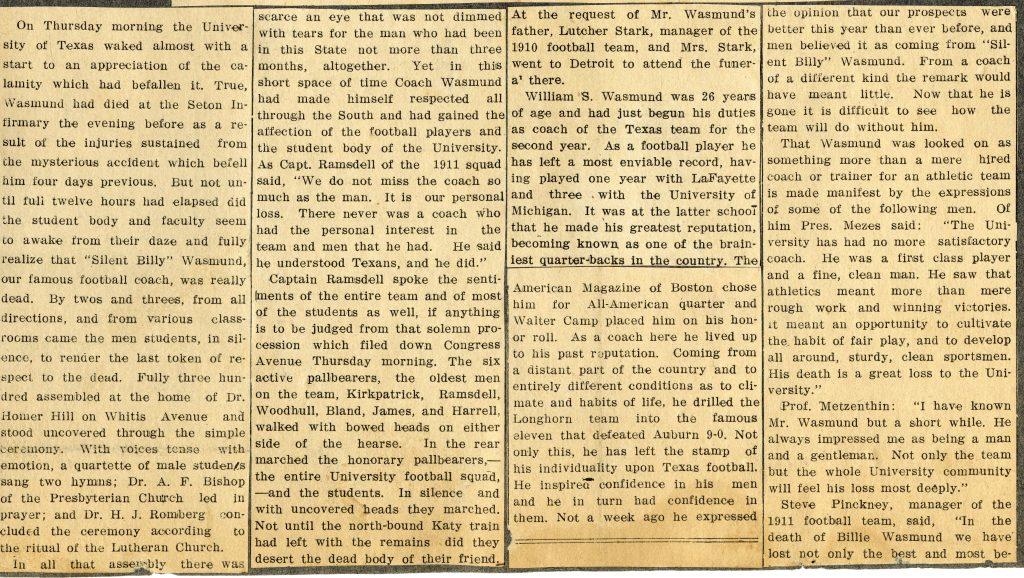 Article after Wasmund’s Death
Article after Wasmund’s Death
The funeral took place on Monday, the 9th, and traffic was almost suspended on the busy streets of Detroit. The shop windows had newspaper or journal clippings of him from the past and he was hailed as a football idol. Hundreds of friends and admirers, including Yost and the entire Michigan football squad, paid their respects at the funeral home where sermons were delivered in German and English. It was estimated that nearly 3,000 people accompanied the body to his final resting place.
 Article on Wasmund’s funeral
Article on Wasmund’s funeral
The UT Football Advisory Council, comprised of Coach Metzenthin (basketball), Dr. Charles Ramsdell and James Hart, chairman, announced to the players on the field that J. Burton Rix, the Track & Field Coach, would step in as head coach until a suitable replacement could be found. Coach Yost was once again contacted for a recommendation. This time, he recommended his former standout player and one-year assistant coach, Dave Allerdice, for the position. Allerdice had just taken the Butler University head coaching job in his hometown at the start of 1911 but after the team’s first game in early October, he left to become the head football coach at the University of Texas. It’s interesting how two University of Michigan football players helped shape the future of Longhorn football. Coach Wasmund would probably have liked being succeeded by another Michigan man.
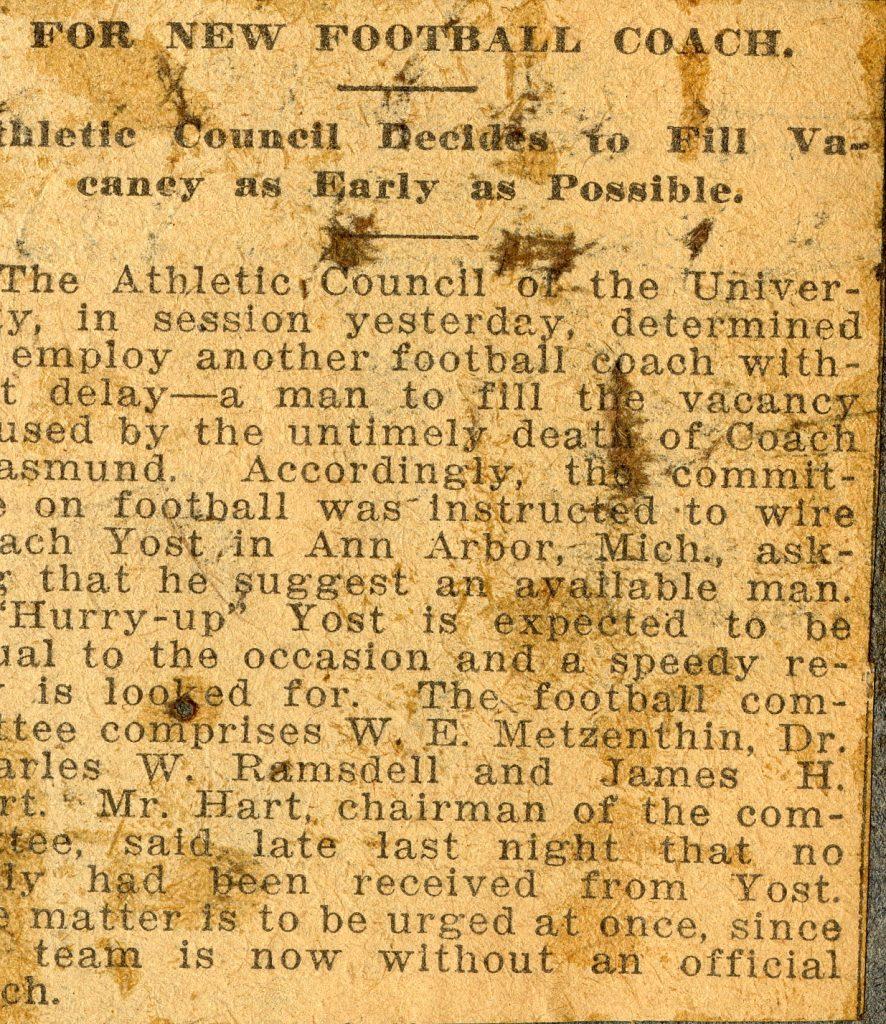 Article on the search for a new coach
Article on the search for a new coach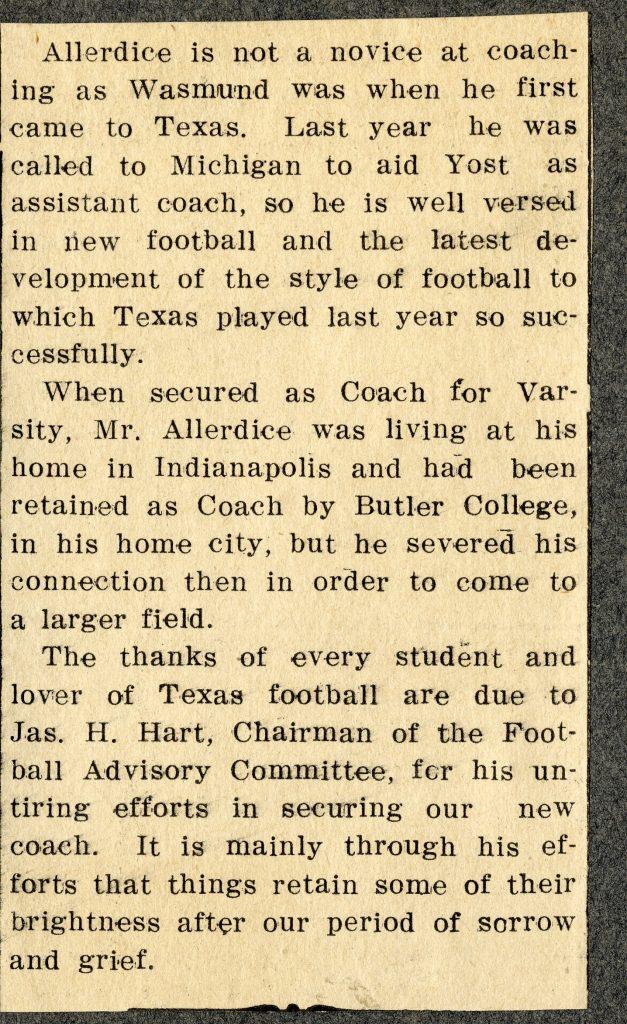 Allerdice named as UT football coach
Allerdice named as UT football coach Dave Allerdice newspaper article
Dave Allerdice newspaper article



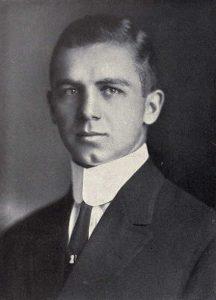






Leave a Reply